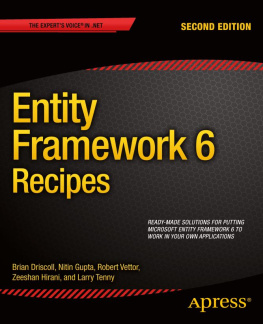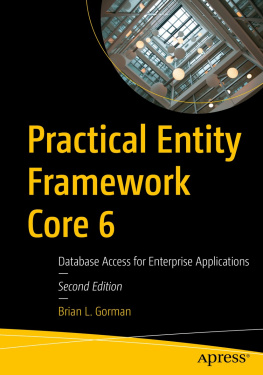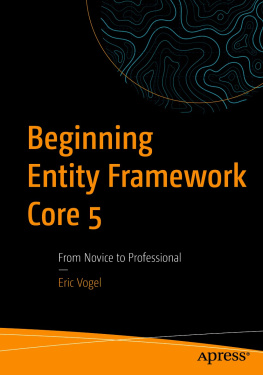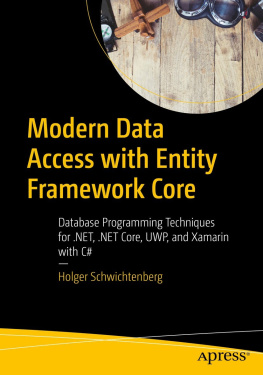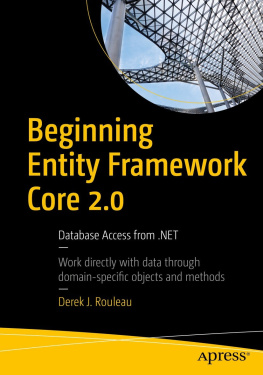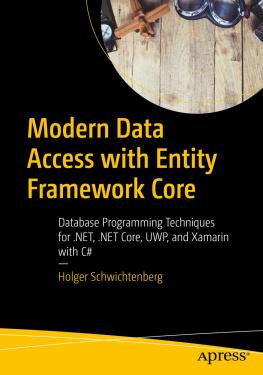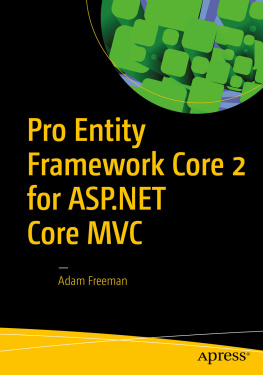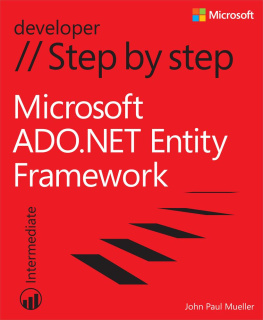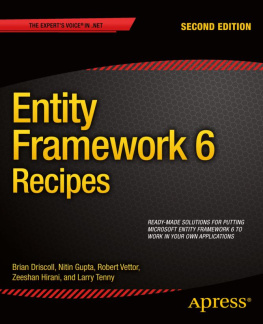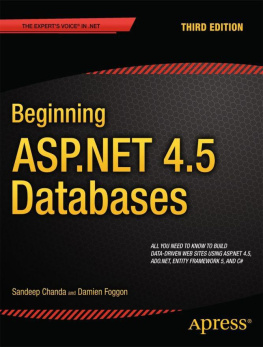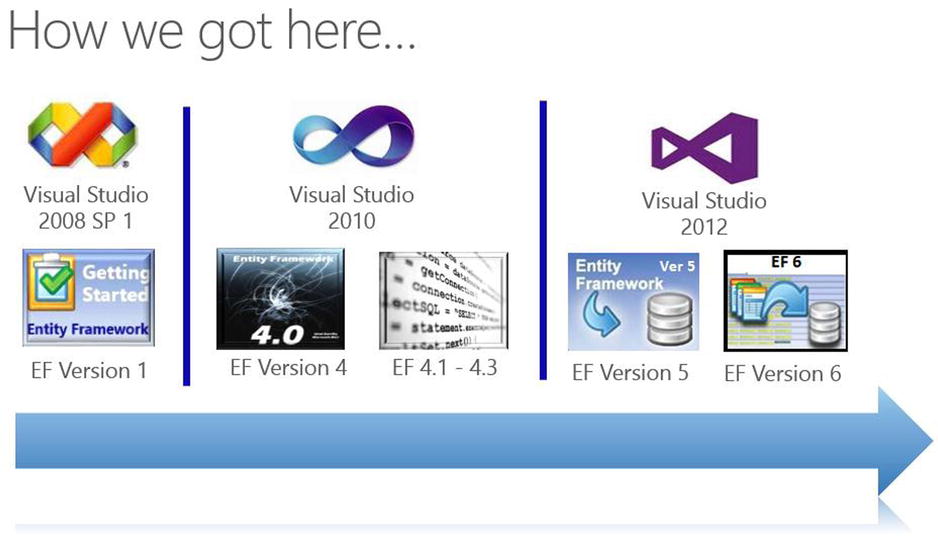1. Getting Started with Entity Framework
Abstract
When working with relational databases, we think in terms of tables with rows and columns. Tables are highly structured and excel at set-based processing. Before the wide adoption of object-oriented programming, we thought about problems procedurally and solved them by writing code in a structured, top-down manner, function after function. Both worlds lined up well: Tables, rows, and columns closely matched the structured and procedural patterns in our code. Life was good - for a time
When working with relational databases, we think in terms of tables with rows and columns. Tables are highly structured and excel at set-based processing. Before the wide adoption of object-oriented programming, we thought about problems procedurally and solved them by writing code in a structured, top-down manner, function after function. Both worlds lined up well: Tables, rows, and columns closely matched the structured and procedural patterns in our code. Life was good - for a time ...
Much has evolved on the code side. We now think in terms of objects and domain models. We architect, design, and program against real-world things, like customers and orders. We draw nouns in our problem space on whiteboards. We draw lines between them, denoting relationships and interactions. We build specifications and assign work to development teams in terms of these drawings. In short, we architect, design, and program at a conceptual level that is very distant from the logical and physical organization of the database.
While the software development process has dramatically matured and the way in which we reason and solve problems has evolved, the database has not. The data remains locked in the same tables, rows, and columns paradigm, where it has been for many years. Unfortunately, this creates a mismatch (an impedance mismatch , as Microsoft fellow Anders Hejlsberg might call it): Object-oriented class hierarchies vs. a highly normalized database structure.
To cope with this gap, software projects often introduce a database layer that translates application domain classes into the rows and columns saved in tables. This approach has spawned many commercial and open-source data access frameworks; all attempting to bridge the ever widening gap between evolving development processes and structured data. Interestingly, an entire new field of Object Relational Mapping (ORM) has come out it.
The Entity Framework, coupled with the Language-Integrated Query (LINQ) framework, both from Microsoft, enables us to address the mismatch problem head-on. Using Entity Framework, we model entity classes for our application on a design surface or directly in code. Then we model relationships ( associations ) between these entities. In our code, we construct LINQ queries to program against these entities and associations. LINQ allows us to express relational database set concepts directly into our code while working in terms of entity types and associations. All of this helps to streamline our development experience while reducing the overall effort. Instead of coding large numbers of highly redundant ADO.NET data access constructs, we express our data needs in simple LINQ queries. Instead of programming against the schema of a highly normalized database, we code against entity classes. Entity Framework maps entity classes to the underlying database for you.
Note
We use the term entity class or entity object to refer to a class that typically represents a domain item in an application. Domain classes represent real-world objects, such as an Employee, Department, or Manager, which your application will represent and track. The end users and stakeholders of your application should be able to look at the domain classes in your application and say, Yes, thats what our business does. Entity classes define the schema , or properties, but not the behavior, of a domain class. In essence, entity classes expose the state of an object.
1-1. A Brief Tour of the Entity Framework World
Entity Framework is Microsofts strategic approach to data access technology for building software applications. Unlike earlier data access technologies, Entity Framework, coupled with Visual Studio, delivers a comprehensive, model-based ecosystem that enables you to develop a wide range of data-oriented applications, including desktop, Internet, cloud, and service-based applications, many of which will be covered in this book.
The History
Entity Framework is not new. The product dates back to Visual Studio 2008 and has come a long way in features and functionality. Figure gives the pictorial history.
Figure 1-1.
A short history of the Entity Framework
The first version of Entity Framework was limited, featuring basic ORM support and the ability to implement a single approach known as Database First , which we thoroughly demonstrate in this book. Version 4 brought us another approach to using Entity Framework: Model First, along with full Plain Old CLR Object (POCO) support and default lazy loading behavior. Soon after, the Entity Framework team released three smaller, or point releases, 4.1 through 4.3, which represented yet another approach to using Entity Framework: Code First. As shown above, Version 5 of Entity Framework coordinated with the release of the .NET 4.5 framework and Visual Studio 2012, delivering significant performance improvements along with support for enums, table value functions, spatial types, the batch import of stored procedures, and deep support with the ASP.NET MVC framework.
Now we are at Version 6 of the Entity Framework. Version 6 delivers asynchronous support for querying and updates, stored procedure support for updates in Code First, improved performance, and a long list of new features, which we will focus on in this book.
Note
Version 5 of Entity Framework can also be used with Visual Studio 2010. Version 6 of Entity Framework, released with Visual Studio 2013, has tooling/runtime support for Visual Studio 2012 and runtime support for Visual Studio 2010.
To level set, lets take a brief look at some of the key components of the Entity Framework ecosystem. What follows is not by any means a comprehensive description of Entity Framework; that would take hundreds of pages. Well look at just a few key areas to help get you oriented for the recipes that are at the heart of this book.
The Model
Entity Framework is a technology with a strong focus on modeling. As you model with Entity Framework, you will see many familiar genetic markers from previous technologies and patterns. For example, you will, no doubt, see a resemblance to entity-relationship diagrams and the widely adopted conceptual, logical, and physical design layering approach.
The model that you create in Entity Framework is characterized by a construct called an Entity Data Model (EDM), which enables you to code against strongly typed entity classes, not database schema and objects. (Figure shows this model in conceptual form.) The Entity Data Model enables you to customize the mappings between entity classes and database tables to move beyond the classic, one-to-one mapping, or class-to-table mapping.

